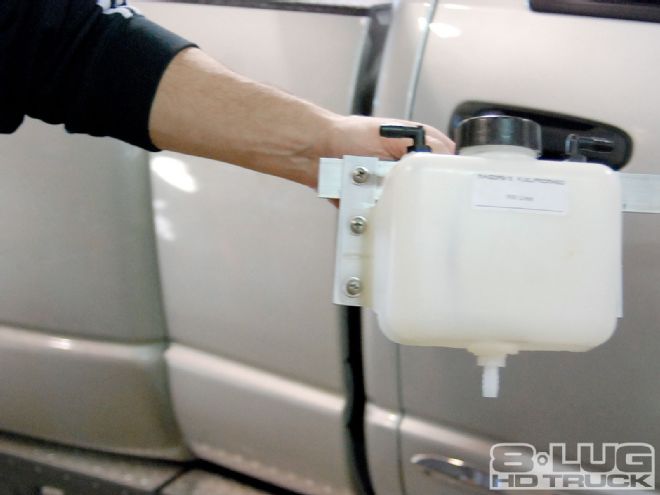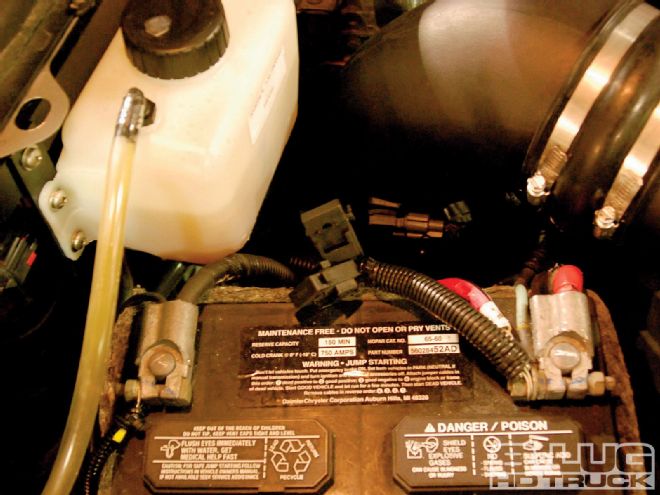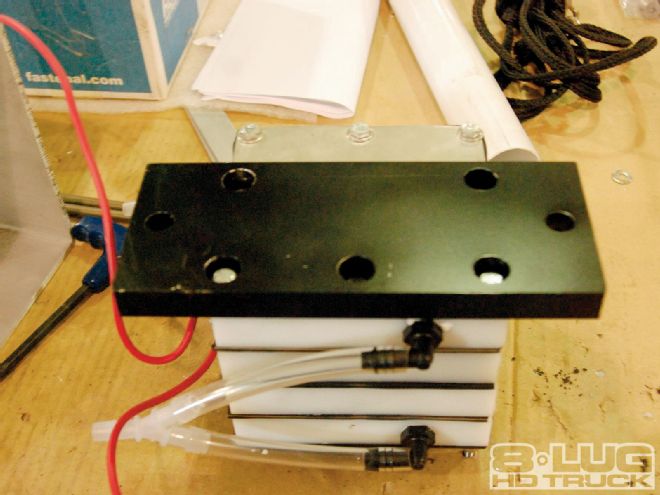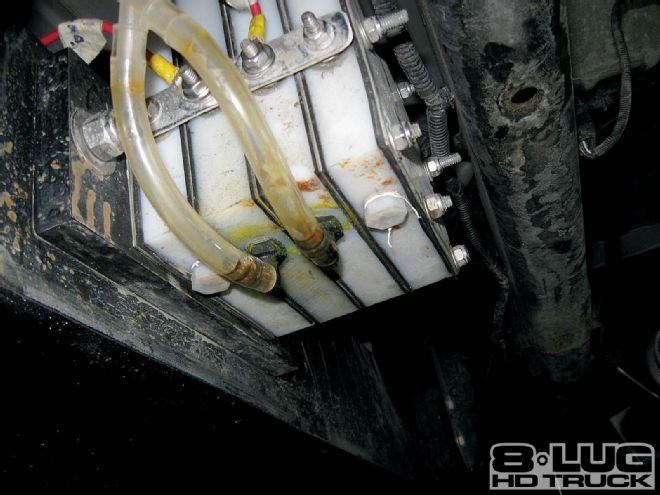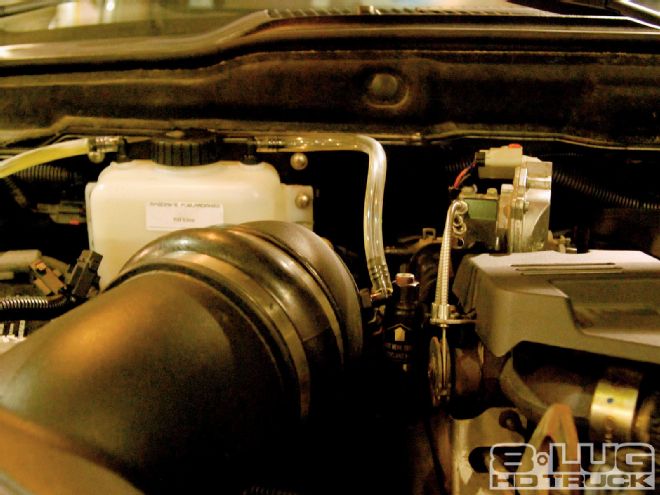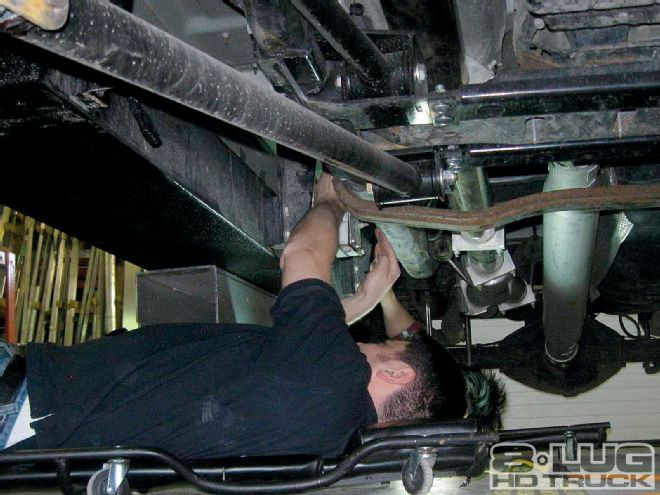Hydrogen generators have been talked about in both positive and negative light over the past few years (particularly on the Internet), so 8-Lug wanted to get an idea of just what was involved and see if they really work. We enlisted the aid of FuelFromH2o.com's Kanan Gubins to install a hydrogen generator on his own '08 Dodge Ram 3500 Cummins turbodiesel (the December '09 8-Lug cover truck) at the Ultimate Truck Gear facility in Toronto, Canada. The following are Kanan's own words.

| The first step in doing modifications to any vehicle is to disconnect the batteries.
By installing an HHO generator, you can enjoy many benefits, including smoother idle, lower emissions, lower exhaust gas temperature, quicker turbo spool-up, and-in most cases-better mpg.
Here is the simplified explanation of how the system works by changing water into hydrogen and oxygen. Let's start with the water. It should be at least filtered or distilled and a gallon is the best amount to have prepared for your HHO generator. The HHO generator produces both hydrogen and oxygen simultaneously through the process of electrolysis.
When water is introduced to electrical current/voltage, it has a tendency to become excited and divides into its primary elements of hydrogen and oxygen. The produced hydrogen and oxygen are now in a gaseous state from the liquid water. It has been said by others smarter than us that the two elements have been split apart from one another into their sub-diatomic molecular state.
A fallacy out there is that it takes more energy to produce the HHO than the energy it releases. This is not at all true-that's why there are HHO generators available out there. You can produce HHO with as little as 1.5 volts DC and an amp of current. It's not only how it's done, but the way in which the HHO generator is configured to permit a useful output with minimal power input. You can put two bare-ended wires into a bucket of water with an electrolyte and produce a small quantity of HHO by putting a DC current through the wires. The idea is to produce as much HHO as possible with the least amount of electrical energy. In reality, once the HHO generator has been charged up, it actually acts like a wet cell battery. It holds a charge of 1.5 to 2.0 volts DC and can operate when charged with the power switch turned off, until the remaining suspended HHO gas is pulled off. The power switch is primarily used to maintain the HHO generator's charge.
We draw off the gaseous material that is produced using the vacuum created by the vehicle's engine and then feed the gases directly into the engine for combustion purposes. This is accomplished by placing a nipple on the air intake system of the vehicle. The system is an on-demand system, not a pressurized storage system. The HHO generator only produces what the vehicle's engine may call for, nothing more.
The process is as follows: You start with water and an electrolyte-there are many different types. You add DC current. The H2O breaks down into H2 & O (we just call it HHO). We introduce it into the engine by use of the engine's vacuum. The HHO combines with the gasoline and air in the combustion chamber and is burnt. Once burnt, it converts back to H20 (water). It then absorbs the inner heat from the engine (normally at 350 to 400 degrees) and turns it into superheated steam. Then it is pushed out of the combustion chamber during the exhaust stroke and out the tailpipe. This lowers the engine's EGT. After leaving the tailpipe, the steam condenses back into water vapor and eventually turns back into water. So you start with water and end with water.
The main reason these products are being used today is they reduce the vehicle's HC, CO, and NO2 emissions to almost zero. In short, the exhaust emissions drop off the scale as we know them and you produce water vapor from your vehicle's tailpipe. Why vapor instead of water??? Since the hydrocarbon fuel produces enough heat during combustion to keep the burnt HHO in a water vapor state, it will totally condense into water outside of the exhaust system (eliminating any internal corrosion).
You're going to ask: Why don't the auto builders or other big corporations utilize this basic technology? Well, it's against their business model. If I can sell you an automobile that runs on inefficient fuel and promise you better mileage next time and you haven't any other choices, what are you really going to do? Why is it that the auto builders have to be mandated to improve vehicle mileage? Because they are in bed with the oil producers and the lot of them are in bed with lobbyists and big banking money.
Here is a little bit of knowledge for you: This technology has been around since the mid-1800s. Yeah, that's right-back before the take-off of the industrial revolution and the heavy use of oil and coal to power our factories and vehicles. But oil and coal was easier technology, easily found, and cheap. Not anymore, though. So if you could gain performance, better fuel efficiency, and smaller bills at the gas pump, would you do it?
Empirical Evidence
A few years ago, I took my personal truck to a smog test center. (Note: This truck does not come with a catalytic converter from the factory, and it has no muffler.) These are the test results from a Wager Digital Smoke Meter, Model 6500:
Test One: 3.5 ppm (with HHO generator not in use)
Test Two: 0.8 ppm (with HHO generator in use) That's a 77.1 percent reduction in ppm. These tests were completed within a five-minute span.
I wrote the shop an email asking if the numbers were right and the decimal point was in the right place, and here is the response I received:
Kanan,
Thank you for bringing the '02 Chevy Duramax through our shop the other day. The Wager smoke meter doesn't read particulate matter to the 1/100th. The meter only reads to 1/10th. Average results for 99 percent of diesel vehicles are in the area of 2.8 ppm to 5.0 ppm during testing. These readings are for vehicles that aren't modified with programmers, haven't had the catalysts removed, and so forth. So a reading of 0.8 is extremely clean by EPA standards set forth for Nevada. It's almost unheard of to have something that clean, be it diesel or gas.
